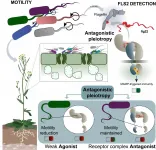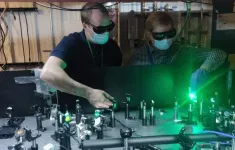(Press-News.org) Scientists have identified new genetic clues in people who've had small and often apparently 'silent' strokes that are difficult to treat and a major cause of vascular dementia, according to research funded by the British Heart Foundation (BHF) and published in The Lancet Neurology.
Researchers discovered changes to 12 genetic regions in the DNA of people who have had a lacunar stroke - a type of stroke caused by weakening of the small blood vessels deep within the brain. Over time, damage to the blood vessels and subsequent interruption to blood flow can lead to long-term disability, causing difficulty with thinking, memory, walking and ultimately dementia.
There are few proven drugs to prevent or treat lacunar strokes. The blood vessels affected are less than a millimetre wide and a lacunar stroke can strike without the person knowing. It's not usually until someone has had a number of these strokes and starts to see signs of dementia that they realise something is wrong.
To date, only one genetic fault has been associated with lacunar strokes. However, after over a decade of research, Professor Hugh Markus and his team at the University of Cambridge working with researchers from around the world now believe their genetic breakthrough holds the key to finding much-needed treatments for lacunar stroke and vascular dementia.
Researchers scanned and compared the genetic code of 7,338 patients who had a lacunar stroke with 254,798 people who had not. Participants were recruited from across Europe, United States, South America and Australia after they attended hospital and had an MRI or CT brain scan.
They discovered that many of the 12 genetic regions linked to lacunar strokes were involved in maintaining the neurovascular unit - the part of the brain that separates the blood vessels from the brain and ensures that nerves function normally. These genetic changes are thought to make the small blood vessels 'leakier', causing toxic substances to enter the brain, and meaning that messages travelling around the brain slow down or don't arrive at all.
The team now plan to test whether new treatments can correct these abnormalities on brain cells in the lab. They hope to begin human clinical trials in the next ten years.
The study also highlighted that high blood pressure, type 2 diabetes and a history of smoking are causally associated with an increased risk of lacunar stroke, identifying things that we can immediately tackle.
Professor Hugh Markus, BHF-funded researcher, leader of the study and neurologist at the University of Cambridge, said:
"These small and often silent lacunar strokes have gone under the radar for a long time, and so we haven't been able treat patients as well as we'd like to. Although small, their consequences for patients can be enormous. They cause a quarter of all strokes and they are the type of stroke which is most likely to lead to vascular dementia.
"We now plan to use this new genetic blueprint as a springboard to develop much needed treatments to prevent lacunar strokes from occurring in the first place and to help stave off dementia."
Dr Matthew Traylor, first author of the study at Queen Mary University of London, said:
"Genetics offers one of the few ways we can discover completely new insights into what causes a disease such as lacunar stroke. It is only by better understanding of what causes the disease that we will be able to develop better treatments."
Professor Sir Nilesh Samani, Medical Director at the British Heart Foundation and cardiologist, said:
"This is the most extensive genetic search to date which truly gets to grips with what cause lacunar strokes. These findings are a significant leap forward and we now have a much greater understanding of the genetics and biology behind what causes the small blood vessels deep in the brain to become diseased.
"Lacunar strokes affect around 35,000 people in the UK each year. This research provides real hope that we can prevent and treat this devastating type of stroke much better in the future."
INFORMATION:
The BHF is funding £24 million of research to better understand, prevent, diagnose and treat strokes and vascular dementia.
A pediatric heart transplant procedure pioneered by Canadian doctors--once deemed impossible--has been shown to be at least as effective as the traditional approach, according to END ...
How can we better understand how people move during the pandemic and how they spread COVID-19? New END ...
From microwave ovens to Wi-Fi connections, the radio waves that permeate the environment are not just signals of energy consumed but are also sources of energy themselves. An international team of researchers, led by Huanyu "Larry" Cheng, Dorothy Quiggle Career Development Professor in the Penn State Department of Engineering Science and Mechanics, has developed a way to harvest energy from radio waves to power wearable devices.
The researchers recently published their method inMaterials Today Physics.
According to Cheng, current energy sources for wearable health-monitoring devices have their place in powering sensor devices, but each has its setbacks. Solar power, for example, can only harvest energy when exposed to the sun. A self-powered triboelectric device can only ...
BIRMINGHAM, Ala. - Researchers have found an unexpected synergy between a T-cell stimulatory protein -- the ICOS ligand -- and interleukin-10, an immunoregulatory cytokine, to prevent inflammatory bowel disease in mice. The study will aid the understanding of, and future research into, this immune disorder, which includes Crohn's disease and ulcerative colitis. About 1.6 million Americans have inflammatory bowel disease.
Interleukin-10, or IL-10, was already known as a major player to prevent gut inflammation by establishing and maintaining immune homeostasis in the gut, where it is vital for the host to have a peaceful coexistence with normal intestinal microbes, while the immune system still stands ...
Efforts to shift from petrochemical plastics to renewable and biodegradable plastics have proven tricky -- the production process can require toxic chemicals and is expensive, and the mechanical strength and water stability is often insufficient. But researchers have made a breakthrough, using wood byproducts, that shows promise for producing more durable and sustainable bioplastics.
A study published in Nature Sustainability, co-authored by Yuan Yao, assistant professor of industrial ecology and sustainable systems at Yale School of the Environment (YSE), outlines the process of deconstructing the porous matrix of natural wood into a slurry. The researchers say the resulting material shows ...
Researchers from the Center for Health, Work & Environment (CHWE) at the Colorado School of Public Health have published a paper in the International Journal of Environmental Research and Public Health studying the effectiveness of applying Total Worker Health (TWH) in an international context. The study, led by a team at CHWE, is the first to examine how a TWH framework operates outside of a western context in Latin America workforces.
"Although recent reviews show that TWH intervention studies have had some global reach, the vast majority have been conducted in Western countries," says lead researcher Diana Jaramillo. "While global organizations, as well as governmental entities in Latin America, acknowledge the importance ...
Researchers at GMI - Gregor Mendel Institute of Molecular Plant Biology of the Austrian Academy of Sciences, the University of North Carolina at Chapel Hill and The Howard Hughes Medical Institute (HHMI) use two complementary approaches to unveil a co-evolutionary mechanism between bacteria and plants and also explain complex immune response patterns observed in the wild. Together the papers change the way scientists have been thinking about the relationship of a bacterial antigenic component with its plant immune receptor. The two papers are published back to back in the journal Cell Host & Microbe.
Immune responses have developed in virtually all organisms over evolutionary time scales to protect them from foreign ...
LOS ALAMOS, N.M., March 25, 2021--A new class of quantum dots deliver a stable stream of single, spectrally tunable infrared photons under ambient conditions and at room temperature, unlike other single photon emitters. This breakthrough opens a range of practical applications, including quantum communication, quantum metrology, medical imaging and diagnostics, and clandestine labeling.
"The demonstration of high single-photon purity in the infrared has immediate utility in areas such as quantum key distribution for secure communication," said Victor Klimov, lead author of a paper published ...
Opioids are the main driver of fatal drug overdoses in the United States, according to the Centers for Disease Control and Prevention, resulting in 46,802 deaths in 2018, usually because the person stops breathing.
Naloxone -- a Food and Drug Administration-approved medication used to reverse overdoses from opioids, such as heroin, morphine and oxycodone -- works by restoring normal respiration to a person whose breathing has slowed or stopped.
"Opioid overdoses cause the largest number of accidental and avoidable deaths," said Peter Davidson, PhD, associate professor in the Department of Medicine at University of California San Diego School of Medicine. "The human toll of drug addiction is devastating. Using naloxone to prevent opiate overdoses can and has saved many lives."
In ...
A major goal of organic and medicinal chemistry in recent decades has been the rapid synthesis of three-dimensional molecules for the development of new drugs. These drug candidates exhibit a variety of improved properties compared to predominantly flat molecular structures, which are reflected in clinical trials by higher efficacy and success rates. However, they could only be produced at great expense or not at all using previous methods. Chemists led by Prof. Frank Glorius (University of Münster, Germany) and his colleagues Prof. M. Kevin Brown (Indiana University Bloomington) and Prof. Kendall N. Houk (University of California, Los Angeles) have now succeeded in converting several classes of flat ...






